|
|
|
|
|
|
 Official name: România (Romania). For the proper pronunciation see language note below.
Area: 238'000 km² (almost as big as the UK or Michigan)
Population: 22.3 million* (2003) - (around 1/3 of the UK population)
Ethnic groups: Slightly less than 90% are Romanians, 6.5 % Hungarians,
2.5 % Roma (there's a huge gap between official and unofficial figures!), furthermore there are
German, Ukrainian, Russian, Turk and other minorities.*
Religion: Corresponding to the ethnic share: almost 90% are Romanian-Orthodox,
others include Greek-Orthodox, Catholic, Protestants etc.
Time zone: As in middle Europe: GMT +01 hr, with daylight-saving time (+1 hour) in summer.
Language: Romanian.
As the attentive reader already might have assumed, the language derives from Latin. From a Latin dialect, to be exactly. However,
the language was greatly influenced by other, mostly Slavic languages (example: the word for 'yes' is 'da' - same as in Russian).
Nevertheless, knowing a Slavic language, eg Russian or Czech, doesn't help at all in Romania. A good knowledge of French or Italian is definitely
more helpful. Many young people speak English fairly well, some even excellent. But personally I've got the impression that German is much more
common. Romanian uses Latin script, but there are some diacritical marks: â, ă, î, ş and ţ.
Official name: România (Romania). For the proper pronunciation see language note below.
Area: 238'000 km² (almost as big as the UK or Michigan)
Population: 22.3 million* (2003) - (around 1/3 of the UK population)
Ethnic groups: Slightly less than 90% are Romanians, 6.5 % Hungarians,
2.5 % Roma (there's a huge gap between official and unofficial figures!), furthermore there are
German, Ukrainian, Russian, Turk and other minorities.*
Religion: Corresponding to the ethnic share: almost 90% are Romanian-Orthodox,
others include Greek-Orthodox, Catholic, Protestants etc.
Time zone: As in middle Europe: GMT +01 hr, with daylight-saving time (+1 hour) in summer.
Language: Romanian.
As the attentive reader already might have assumed, the language derives from Latin. From a Latin dialect, to be exactly. However,
the language was greatly influenced by other, mostly Slavic languages (example: the word for 'yes' is 'da' - same as in Russian).
Nevertheless, knowing a Slavic language, eg Russian or Czech, doesn't help at all in Romania. A good knowledge of French or Italian is definitely
more helpful. Many young people speak English fairly well, some even excellent. But personally I've got the impression that German is much more
common. Romanian uses Latin script, but there are some diacritical marks: â, ă, î, ş and ţ.
ă is read as the weak [e] in [ the ] (phon: ə),
â is read as a weak, almost nasal [ i ]. Close to the
[ i ] in [nifty] (phon: ɨ, i ), the pronunciation of î is practically the same.
ţ is pronounced as the [ ts ] in [ tsar ] and
ş as the [ sh ] in [ rush ]. The combination
gh is mostly read as the [ g ] in [ leg ].
|
|
|
|
|
|
|
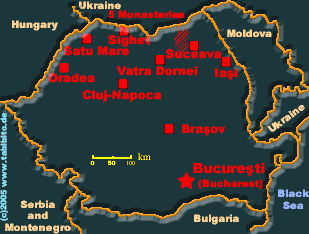 Romania can be divided into several cultural-historical landscapes, as there are the Bukovina & Moldavia (
not to be confused with the →Republic of Moldova) in the north-east,
Maramureş in the north-west, Banat in the west, Wallachia in the south,
Dobruja in the southeast and finally the famous Transylvania (aka Siebenbürgen) in the
centre of the country. The Carpathian mountain range looms from the north into the country like a huge hook. The highest peak of the country
is 2,543 metres high Moldoveanu right in the centre of the country.
Romania can be divided into several cultural-historical landscapes, as there are the Bukovina & Moldavia (
not to be confused with the →Republic of Moldova) in the north-east,
Maramureş in the north-west, Banat in the west, Wallachia in the south,
Dobruja in the southeast and finally the famous Transylvania (aka Siebenbürgen) in the
centre of the country. The Carpathian mountain range looms from the north into the country like a huge hook. The highest peak of the country
is 2,543 metres high Moldoveanu right in the centre of the country.
Especially Transylvania is dominated by more or less high mountains. The rest of the country mainly consists of rolling hills or large plains.
The Dobruja (the Northern Dobruja, to be exactly - the Southern part belongs to →Bulgaria)
features the Danube delta with countless river arms, forming one of the last natural river reserves in Europe (although there
was a lot of damage done, too).
Soaking in the Black Sea, climbing in Transylvania, hiking in Maramures or the Bukovina - there's plenty to do in Romania. Wide parts of the
country are sparsely populated, and in some areas nothing seemed to have changed over the centuries. A perfect place to experience
"Ye Olde Europe".
In wide parts of the country, the climate is rather continental. It can become quite hot in summer and very cold in winter - with lots of snow in winter.
Naturally, the weather in the mountains is often unpredictable, with snow even in June and more rain than in the rest of the country.
|
|
|
|
|
|
|

| |
Vlad Ţepeş-Street in Braşov
|
During the 14th and 15th century, local rulers successfully fought back the Ottoman approach to advance northwards. Among those
rulers, there was the Prince of Wallachia, known as Vlad Ţepeş. "Ţepeş" was his nickname, which
means 'The Impaler'. Vlad had a bad habit regarding the execution of Turk captives. A sharp stake was carefully driven into their backbone,
and after that the stake was put upright. The injury wasn't fatal - at least not during the first two days! Chronicles say that
the poor devils were fully conscious until they died (historical drawings depicting the impaling can be seen in the fortress
Rasnov near → Brasov). Bram Stoker heard about the stories and created the famous novel on Dracula based upon
Vlad Ţepeş.
In the 16th century, the rulers could not withstand any longer the Ottoman attacks and were occupied. However,
the region was granted wider autonomy. After the defeat of the Ottomans at the gates of Vienna in 1683, Transylvania was
'liberated' by Habsburg's Austria. The rest of the region remained under Ottoman control until 1881.
In World War I, Romanians fought against Austria-Hungary, and so it was one of the winners of the war. As a result,
Banat and the Bukovina were added to the Kingdom of Romania, which only consisted of Moldavia (incl present-day Moldova)
and Transylvania before. The country played a tragic role in the Second World War. A pro-fascist dictatorship was established,
making Romania an important partner of Nazi Germany. Countless Jews and Roma fell victim to the fascist regime.
In 1944, the country suddenly made a u-turn and supported the Red Army in their attempt to fight Hungary and Germany.
Ever since, Romania belonged to the Soviet sphere of influence, with the left gradually getting the upper hand. In 1947,
the monarchy was abolished and so Romania became a socialist country. However, the leaders of the country kept their distance
from the big brother in the east. In 1965, Nicolae Ceauşescu took over and eventually
got the title of the President of Romania in 1974. Despotism as well as mismanagement, combined with chronic megalomania,
weakened the country substantially. Ridiculous projects sucked the country dry, leading to famine and eventually to bloody unrests in
the 1980ies. Even in other socialist countries of Eastern Europe, Romania was an infamous place better to be avoided.
Uprisings reached their climax in 1989. Party leaders 'understood' and arrested Ceauşescu and his unpopular wife.
A few days later, they were spontaneously executed after a short and secret trial. I wonder why they've been in such a hurry...
The next years were rather chaotic. Until 1996, it remained under the rule of the socialist party. Today, the country is trying hard to
get closer to the rest of Europe. Some of the reforms were very painful, but there's great progress. The inflation has been
stopped, but poverty is still a common problem. Anyway, it's great to see how the country is flourishing at the moment.
Before 2010, Romania is scheduled to gain full EU membership.
|
|
|
|
|
|
|
Visa:
Romania substantially relaxed its rigid visa policy a few years ago. Most (or all!?) EU citizens and Americans do not require a visa any longer.
A valid passport is everything you need. Other nationalities still seem to require a visa, but a letter of invitation is not necessary.
Money: The Romanian
currency is called Leu (Plural:
Lei). Many years ago, one Leu consisted
of 100 Bani, but due to the inflation the Bani
has vanished. In summer 2004, the average exchange
rate was € 1 = 40,500 Lei. The inflation
rate is very low now, so the rate won't change
as much as it did years ago. There are three coins
with a 500, 1000 and 5000 Lei denomination. Notes
come in 2,000, 10,000, 50,000, 100,000 and 500,000
(haven't seen anything higher) Lei denominations.
But - the Romanian Leu has been revaluated in
Summer 2005: 4 zeros were cut, but besides this
the paper money didn't change much of its appearance.
Old money remains valid until the end of 2006.
The recent exchange rate (again, very stable!)
is € 1 = 3.5 Lei.
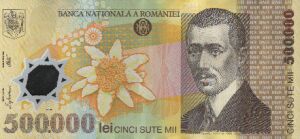
| |
Sophisticated Romanian 500,000 Lei note
|
Costs:
Romania is (still!?) a very cheap destination for travelers. Accommodation in
plain but mostly clean hotels or pensions is mostly around € 10 per person in a double room. Self-catering is not
really necessary unless you're planning to hike in remote areas, since eating out in normal restaurants
rarely costs more than 2 or 3 Euro. The same can be said about travelling by train.
To give an example, a single ticket for the express train (rapid) from Braşov to Bucharest will set you back € 5 only.
Taxis are quite inexpensive, too: In Bucharest, there's a fixed fare of 40,000 Lei for the first few kilometres,
which is usually enough for most rides in the city. In other cities, the regular fare is usually between 6,000 and 9,000 Lei per
kilometre. Usually, the price per kilometre is printed on the driver's door. However, some taxis do not have a meter or drivers
'forget' to switch it on. Hence, it's better to check beforehand. If there's no meter, agree on the fare before you start.
If it's a longer distance, it's definitely worth haggling a little bit.
If you don't need luxury but fancy a nice meal and extensive sightseeing, you will easily get by on € 30 a day (incl. train tickets and
everything). Self-caterer (groceries are omnipresent, open until late at night and are called Alimentare)
bringing their own tent will easily get by on € 10 per day or less. By the way, a beer in a restaurant or bar usually costs around 15,000 Lei (€ 0.4)
a pint.
Getting there:
By bus, train, boat or plane - everything's possible. And except for the →Ukraine and
→Moldova, most nationalities do not require a visa for the neighbouring countries. There are many
direct flights from all major European airports. The main airport in the country is Otopeni Int'l Airport 17 km north
of the capital.
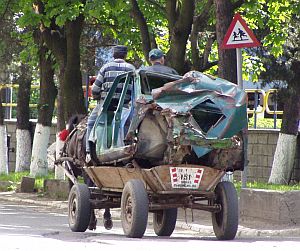
| |
Don't worry if your car is broken...
|
A more relaxed and interesting way is to get there by train. Unfortunately, there are no direct connections from Western Europe.
It's necessary to change trains either in Vienna or in →Prague respectively
→Budapest. So far there's no discount ticket available for Romania. And so the fare for a single ticket
from Germany to Braşov via Dresden and →Prague costs around € 140, incl.
the fee for the sleeper. The trip takes more than 24 hours, but it's a relaxed train ride. When coming from another European country, it's much cheaper
to travel from border to border, crossing the border on a local train. Of course this is very time-consuming. The German railway company offers
so-called Spar-Night tickets - from Germany to →Budapest, the price for a
return ticket on a sleeper is € 98, but it's necessary to book in advance. From Budapest to the Romanian border, it's € 8 only.
Austria offers CityStar-Tickets, which are a good bargain, too. There's no discount ticket for Romania, but it's cheap to
go like this via →Hungary or →Serbia.
According to several reports, traveling the country by car can still be dangerous - some people talk about muggings,
police arbitrariness, accident fraud etc. Personally I think that the situation has improved a lot and streets are pretty safe. However, traffic in the
capital is just gruelling, not to say a pure nightmare, and this won't change over the next years.
Border:
Nothing is easier than crossing the border to Romania: Most border guards are very friendly, almost no or at least no strict luggage control is applied
and there are large boards everywhere saying that corruption is strictly forbidden etc. There are also useful telefon numbers where travelers can
complain. Many years ago, crossing the border to Romania was nightmarish - even for humanitarian aid workers. Today it's a piece of cake.
There are numerous border crossings to the neighbouring countries. However, some of the border crossings to the →Ukraine
are for locals only - only one crossings can be used by travelers (that's the one near →Suceava.
Getting around:
You can get around by bus, train or plane. Since large parts of the country are mountaineous,
it can take a while to get from A to B.
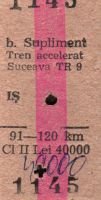
| |
Train ticket
|
Local trains are called personal. They cost only half the price of the accelerat,
but they are incredibly slow and often overcrowded. Personals stop at every tree,
and they often wait 10 minutes or so for faster trains to pass by. Attention:
Usually, departure times (plecare) and arrival times (sosire) are written on the same timetable,
which can be very confusing. Note that there aren't many trains crossing the border.
If you see two large towns on the map - one in Romania, the other one in a neighbouring country - connected
by a railway line, it doesn't necessarily mean that there are trains. And so it can become very tricky to
get from →Satu Mare to →Debrecen
for example.
Buses are only helpful if there's no train connection. Local buses are often slow and dirty;
long distance buses are not much better. You can stop most buses everywhere you like. Which is very convenient,
but on the other hand it means that it can take hours to cover 100 km or so. In most towns, the
autogară (bus station) can be found somewhere near the train station
(unless the train station is far away from the centre).
Food & Drinks:
Well, Romanian food can be quite tasty, but after a week or so of Romanian food only I'm starting to yearn for
something else (my opinion). Quite famous and omnipresent is the so-called
Ciorbâ de Burtâ, which is a white, slightly sour tripe soup. Definitely not
everyone's cup of tea!
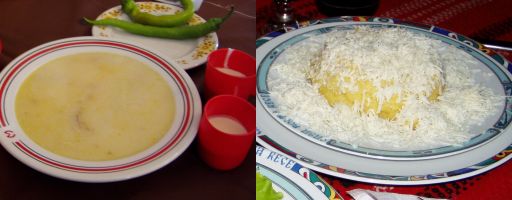
| |
Ciorbâ de Burtâ (left) and Mâmâligâ & Brânză
|
In restaurants, waiters always ask if you want some Pâine (also Pîine) (white bread)
with your meal. It costs a few Lei extra. After a couple of days with Mâmâligâ and/or
Cartofi (potatoes, mostly fried), you might want to try one of the many Italian restaurants. Recently they've mushroomed
everywhere, in some towns they even outnumber Romanian restaurants. Some of them are lousy, others are really excellent.
Note that the sign 'restaurant' doesn't always mean that there's food - sometimes it's just a simple bar serving drinks only!
Romania is quite famous for its vin (wine), as for example Murfartlar.
Beer is quite common as well - especially the brand Skol can be recommended. And there are
numerous types of firewater - probably the most famous one is called
Ţuică (plum brandy), others include Raki (usually made of grapes)
and others. Vodka is popular, too - there's a brand called "Stalinskaya", but this is better to be avoided.
The South Bukovina is well known for its fine cherry and other liquors (see also
→Suceava). Coffee is often boiled with suggar and therefore very sweet. Espresso and
coffee (cafea) are standard today (which wasn't always like that). However, the further you go to the west, the better the
coffee is.
|
|
|
|
|
|
|
domino.kappa.ro/guvern/istoria-e.html
Very extensive historical overview and interesting reading material. English and Romanian.
www.meetromania.info
Very nice project by some Romanians trying to promote the country. In English, incl. many pictures.
www.virtualtourist.com/m/30132/35f
Interesting website of a Bucharest citizen - first hand information so to say. English.
www.dictionare.com
Always useful: Online Romanian ↔English dictionary.
Do you have or do you know a good website about Romania? Don't hesitate, let me know!
After checking it, I would love to add it to the link list.
Please note that commercial websites will be declined. For e-mail link see menu on the left.
|
|
| |